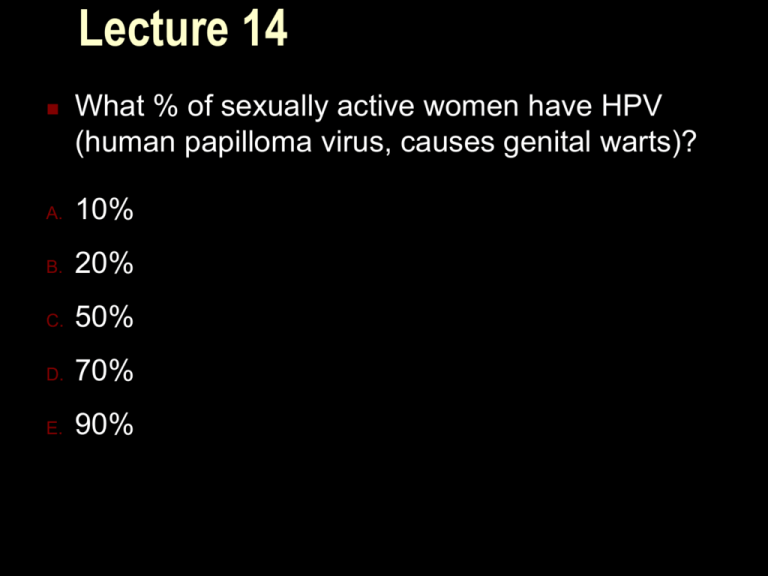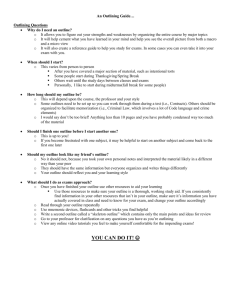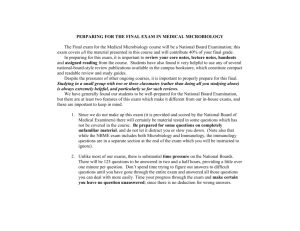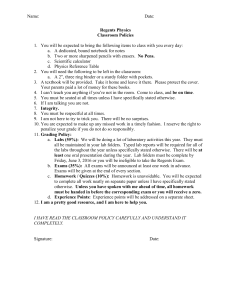
Lecture 14
What % of sexually active women have HPV
(human papilloma virus, causes genital warts)?
A.
10%
B.
20%
C.
50%
D.
70%
E.
90%
Fostering Critical
Thinking in a large
lecture Microbiology
course
Erica Suchman, Ph.D.
Department of
Microbiology, Immunology
and Pathology
Colorado State University
My class
Junior and Senior level students
10% micro majors
90% from 30 other majors
70-200 students/section
3, 1 hour lectures, separate lab
The Problem:
Students were unable to “think” about
microbiology on exams.
The Solutions:
1.
Daily handouts with ungraded
problems
2.
3.
4.
This did not really work
Interactive Demos
Group Exams.
Clicker questions
The Problem
Students don’t know each other
making it difficult to form study
groups.
The Solution
Students
card exchange, the first day
of class
Group Exams
Forming Groups
Students are allowed to self select
groups
minimum 4 students can have as
many as they want
Big
Debate: self selection vs.
assigned groups
Group Exams
Group exams are designed to make
students use the material & critical
thinking to solve problems.
Group exams are designed to be too
difficult to answer during one class
period.
Students are told the types of
questions asked on the group exams
will be used on their individual exams.
Group Exams
Students are given the exams 1 week
before they are to take them.
They are told they are expected to
work on these outside of class, & that
they will not be able to finish them if
they come to class unprepared.
They have 35 minutes, the last 15
minutes of class we go over the
answers.
Group Exams
Exam day the group decides on best answer, fills
out answer sheet & turns it in for a group score.
Students may fill in a page of dissent.
If the dissenter is correct only they will get the
points, if they are wrong only they will lose points.
Students must be present during the group exam
to get credit. I verify the presence of students
during the exam, helps me to learn their names.
The last 15 minutes of class the students develop
the key by answering questions about the group
exam using their clickers.
Metabolism Group exam
1. Your first assignment is to provide
information to the firm BigMoney Inc,
interested in using microbes to clean
toxic spills (bioremediation). BigMoney
Inc. has had a major spill of inorganic
N02- . They want to know on a strictly
theoretical basis if there are any types
of bacteria that could metabolize N02to give rise to NH4?
ANSWER
N02- NH4 Nitrite is reduced. Which means
that Nitrite is accepting electrons. As this is
a non-Oxygen acceptor it is by definition
anaerobic. Nitrite could serve as the final
electron acceptor in either anaerobic
respiration or anaerobic
chemolithotrophy. In anaerobic
respiration Nitrite would accept electrons
from organic materials and in
chemolithotrophy Nitrite would accept
electrons from inorganic materials.
Group exams we do
1: Determining the identity of field isolated
organism based on their characteristics:
comparing eubacteria, archea, &
eukaryotes; classification.
2: Metabolism & bioremediation
3: Transcription, translation and mutations
4: Viral life cycles and anti-viral drugs.
The Problem
Students can’t visualize and see how
they might use complicated biological
processes from traditional lectures
The Solution
In class student centered
demonstrations
Clicker questions
Now for a little movie
Student centered Demos
Conjugation and Hfr mapping
Transduction
Transcription
Translation
The Ames test
Isolating auxotropic mutants (His-)
Herd immunity
Clicker questions should have a goal
My goals:
1. Make sure I see if they are understanding
difficult topics so I will know if I need to talk more
about this topic
(studied,
~84 times went over a concept again due
to poor response on clicker question)
2. Let them see the ways they need to be able to
use and think about concepts, re-enforce that
memorization alone is not going to get them an A
3. Keep them involved with the topic during
class, reduce the passive nature of our exchange
4. Review information discussed in a previous
class period that will be needed for today
Questions should not be
Used only as an attendance tool
Used only as a quizzing tool
Used only infrequently
Used when use will not augment learning
Extra Credit Questions
The second class starts the students are asked
to answer a question from the previous lecture.
They have 45 seconds to answer
If they get it correct they can get extra credit.
15 times during the semester I pick the start of
class question to be worth extra credit, if they
got the correct answer on that day they can get
1 point for a total of 15 points (out of 600).
Not for credit questions to
increase learning
The following are examples of questions I use to ensure
that
I can see if the students understand the concepts
Students can see the ways I expect them to be able to use
information, not just memorize information
A technique I often use is to have students answer
alone, I show them the class’ answers, but no correct
answer, they then talk about it and re-answer
The percent answering correct increases on average of
22%
Example: Shapes, & arrangements
cocci (s. Coccus): round, spherical
Diplococci, remain together, pairs
Streptococcus, remain together, long chains
Staphylococcus, in random planes, grape like
clusters
Tetrads, in 2 planes, 4 cell groups
Sarcina, in 3 planes, 8 cell groups
Bacilli (s. Bacillus): rods, different length to width
ratios, different ends, flat, round
Coccobacillus, short and wide, resemble cocci
Justice and Suchman
Diplobacillus, remain together, pairs
Streptobacillus, remain together, long chains
Vibrios, curved rods, commas
Justice and Suchman
Spirals, long rods twisted into
corkscrews
spirilla, corkscrew with flagella
spirochete, corkscrew
no external flagella
5. What is the correct shape and arrangement for the
following bacteria?
A.
B.
C.
Staphylococcus D. Streptobacillus
Staphylobacillus E. Streptococci
Sarcina
Example 2: lymphocytes respond to
Epitopes on Antigens
complex molecules
proteins
polysaccharides
glycolipids
Antigens may have more than 1 epitope which
elicits lymphocyte response
Bacteria
Antigen with 2
epitopes
Antibodies bound to
epitopes
2. You have 3 proteins on the surface of one bacterium
that serve as antigens. Protein A has 3 antibody binding
sites, Protein B has 4, and Protein C has 2. How many
different B lymphocytes will be specific for this
bacterium?
A.
B.
C.
3: 1 for each
antigen
1: that is
specific for
this
bacterium
9: 1 for each
epitope
No Answer
Start of class Hook questions
Class starts with a “Hook question” that is up
while I set up for class and I start ~2 minutes
before class officially starts.
Misconception about microbiology
Usually about a disease
Something they find interesting
Allows students to get their clicker ready and
gets them thinking about micro before class
starts
Not worth any credit
How many women a year
get diagnosed with HPV
related cervical cancer in
the US?
A. 140
B. 1000
C. 6000
D. 14000
E. 100,000
Something New I tried S08
On any given day ~20% of my class was not in
attendance.
I gave extra credit for near perfect attendance.
Each student will get credit for clicking each
day. If they don’t miss more than 2 classes they
can get an extra 5 points of extra credit (out of
600 points)
All or nothing 0 or 5 no partial credit
Interesting things I learned
By giving them 5 points for not missing more than
2 classes 80% of the class did not miss more than
2 lectures (compared to 45.6% in F07)
The % of students who chose to purchase the
clickers went up from 95.3 to 99.8%
The % of students who attended class each day
increased to an average of 89.2% (from 80.52%)
The % of lectures attended by students increased
to 90.6% (from 80.52%)
Grading
Individual exams
3 midterms 100 points each
final 200 points cumulative
Total points possible
600 points
500 from individual exams
100 from group work (4 group exams 25
points each)
Up to 20 points extra credit 15 getting start of
class questions correct, 5 for not missing more
than 2 classes (average ~14)
Things I Have Learned
Marketing matters.
Pay attention to your goals while
writing questions.
Although fostering critical thinking
increased my workload, I feel it is
worth the effort.
Our clicker study:
The Literature tells us that
New students or students with lower achievement levels
have trouble in larger classes (Bordon and Burton 1999;
Dillon and Kokkelenberg, 2002 ).
Research on learning shows that individuals make meaning
in a variety of ways and that these ways may not be the
same for each individual (Denig 2004 )
Learning takes place in social settings through interaction
with others. In other words, some learners need to interact
with others in order to make sense of new information prior
to internalizing it (Vygotsky,1978). .
Research has documented a variety
of benefits of using CRS
(Best Reference Duncan, 2005)
Increased
Attendance
Preparation for class
Enthusiasm
Attentiveness
Participation
Confidence in learning
What they have not looked at is - does how you use the
clickers have an effect on these benefits?
The Study
Instructor A (me) integrated CRS use throughout
my lectures as well as beginning each lecture
with an extra credit question covering the
material from the previous lecture.
Instructor B (Ralph Smith) only used CRS for
beginning of class extra credit questions
The following parameters were compared
between the classes
1.
The number of times students worked cooperatively
during the semester
2.
The number of times the instructor changed lecture
due to lack of student comprehension
3.
Performance on shared questions on exams that were
either only covered by lecture in both sections, or by
both lecture and CRS questions in section A
4.
Attendance
5.
Responses to a end of semester survey
I reported making changes in lecture due to
lack of student comprehension 83 more
times than my teaching partner in section B
that used CRS as only a quizzing tool
Total # of CRS
questions
asked during
semester
# of formal
student
interactions
with other
students
# of changes
in planned
lecture due to
CRS
questions
Section A
112
27
84
Section B
28
7
1
Student’s scores improve
dramatically when they discuss the
question with peers
120
100
% correct 1
% correct 2
60
40
20
ge
ra
19
Av
e
18
17
16
15
14
13
12
11
10
9
8
7
6
5
4
3
2
0
1
Percentage Correct
80
Question Number
Students in section A did better on all
test questions, not just the ones that
were covered by CRS questions as we
predicted
120
Average Score on Questions
100
80
Section A
Section B
60
40
20
0
CRSQ E1 Non-CRSQ CRSQ E2 Non-CRSQ CRSQ E3 Non-CRSQ CRSQ E4 Non-CRSQ CRSQ All Non-CRSQ
E1
E2
E3
E4
All
Question type and exam number
Performance on beginning of
class questions
The average percent correct was ~75% for both
section A and B
This suggests the 2 classes should have
performed similarly on exams
Statistics
When student performance was compared
between the 2 classes for
Section
Exam
Question type (CRS covered or not)
The only significant difference was between
sections
With Section A performing significantly better on
all types of questions and on all exams
Attendance?
•There was no difference between
the sections in the students who
purchased the clickers
•However in section A 8% more
students chose to purchase the
optional clickers
And the survey says….
Students in section A reported
feeling more confidence about their knowledge
More interaction with other students than usual
More ability to give the instructor feedback than
they usually do
Less doubt about their progress
Greater confidence in their ability to form
relationships between concepts
Than students in section B
Want more info, or to see all the
exciting statistics showing what I
am telling you is true?
Evaluating the Impact of a Classroom Response
System in a Microbiology Course. Erica
Suchman, Kay Uchiyama, Ralph Smith, Kim
Bender, Journal of Microbiology Education, May
2006 Volume 7 pg 3-11
Other References
Blackman, M. S., Dooley, P., Kuchinski, B. and Chapman, D. 2002. It worked a
different way. College Teaching 50:27-28
Borden, V. M. H., and Burton, K. L. 1999. The impact of class size on student
performance in introductory courses: AIR 1999 annual forum paper. AIR 1999
Annual Forum Paper, 21.
Bullock, D. W., LaBella, V. P., Clingan, T., Ding, Z., Stewart, G. and Thibado, P. M.
2002. Enhancing the student-instructor interaction frequency. The Physics Teacher
40 p.535-541
Denig, S. J. 2004. Multiple intelligences and learning styles: Two complementary
dimensions. Teachers College Record 106:96-111
Dillon, M., and Kokkelenberg, E. C. 2002. The Effects of Class Size on Student
Achievement in Higher Education: Applying an Earnings Function. In 42nd Annual
AIR Forum. Ontario, Canada.
Duncan, D. 2005. Clickers in the classroom. Pearson, Addison Wesley,
Boston, MA.
Elliott, C. 2003. Using a personal response system in economics teaching.
International Review of Economics Education 1:80-86.
Roschelle, J., Penuel, W. R., and Abrahamson, L. 2004. Classroom response and
communication systems: Research review and theory, p. 8. AERA 2004 paper
proposal, San Diego, CA
Vygotsky, L. S. 1978. Mind in society: The development of higher psychological
processes. p. 131. Harvard University Press, Cambridge, MA.
Slain, D., Abate, M., Hodges, B. M., Stamatakis, M. K., and Wolak, S. 2004. An
interactive response system to promote active learning in the doctor of pharmacy
curriculum. American Journal of Pharmaceutical Education, 68:1-9
Wit, E. 2003. Who wants to be...The use of a personal response system in
statistics teaching. MSOR Connections 3.
Want more info?
Contact me at…
Erica.suchman@colostate.edu
The group exams can be found on the
ASM Education Resources Web Page
at:
http://www.microbelibrary.org/
Curriculum/page2.htm






